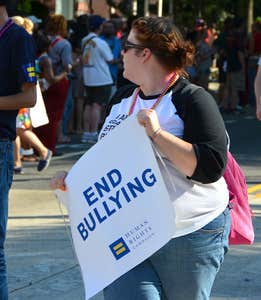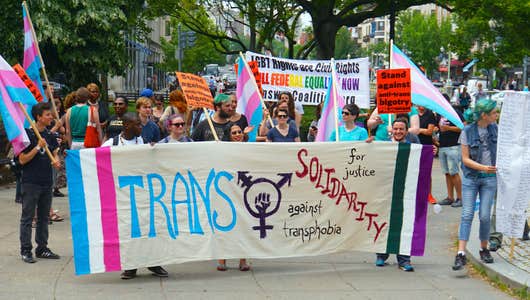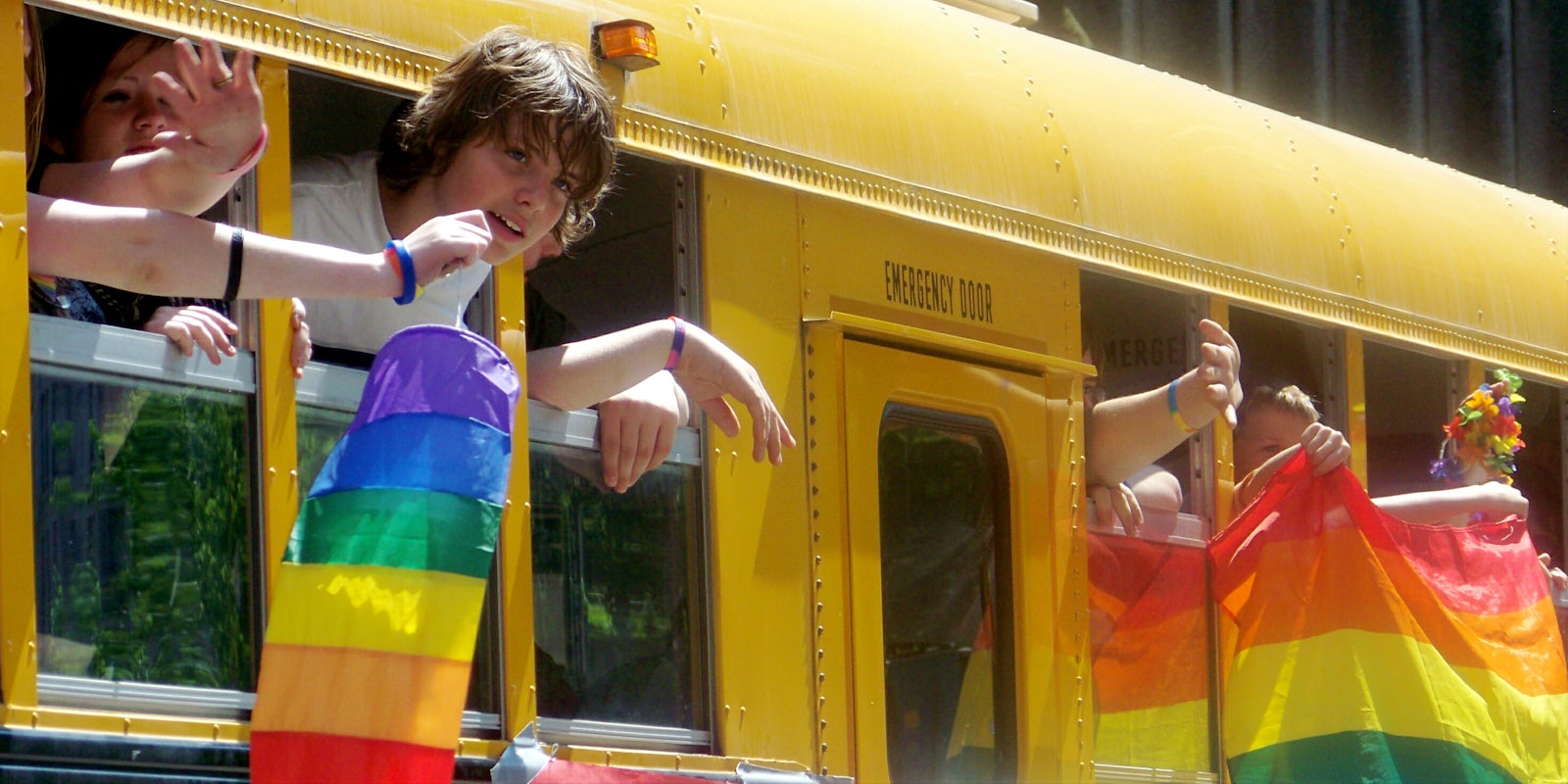Opinion
Last year, California officially mandated LGBTQ history lessons in public schools, vowing to teach “the contributions of lesbian, gay, bisexual, and transgender Americans” and their impact on both the state’s and the country’s history.
This was a victory for LGBTQ rights, because it’s a rarity; in most states—in all but nine to be exact—schools don’t even cover LGBTQ sexuality, let alone queer history.
When surveyed by the Human Rights Campaign (HRC), only 12 percent of millennials said they received sexual education material that covered sex between gay partners—even though 20 percent of millennials consider themselves LGBTQ. American sex ed is “primarily or exclusively focused on heterosexual relationships between cisgender people,” according to a different study conducted by Planned Parenthood and the HRC.
This hetero-specific focus creates a multitude of problems for all young people sorting through their anxieties and questions about sex and sexuality. For one, straight students aren’t being forced to acknowledge other sexualities, which can foster bullying and promote a culture of intolerance. For another, a lack of school discussion means most LGBTQ students are being inadvertently told to stay in the closet. And with that messaging, there is the shame and hiding, and then there are the health risks.
Proper safe-sex education is important for all students, and LGBTQ people are no exception: 22 percent of all transgender women are HIV positive, and queer men face a higher risk of contact with HIV or a sexually transmitted disease, according to the Centers for Disease Control and Prevention.
While ignoring queer students may not be a new phenomenon, it doesn’t mean it doesn’t need to be remedied. And perhaps school districts can start by listening to the stories of queer people who have gone through the country’s lackluster sexual education systems. Through them, activists can learn how to fix such a massive gap in sex education.
This is what the queer sex ed gap looks like
Larissa Glasser, a librarian and writer living in Massachusetts, grew up in the 1980s, an era whose approach to sex ed was based in fear and simple authoritarian phrases like “Don’t do it.” Glasser, whose transgender, obviously couldn’t rely on schools to teach her about queer life.
“I was in public school until fifth grade and we had no sex education whatsoever,” she told the Daily Dot. “This was during the Reagan presidency, so all we ever heard about sex was AIDS as a scare tactic to be abstinent.”
Very little accurate information existed about transgender women outside of schools. Glasser was only exposed to trans people through filmmakers like John Waters and Ralph Bakshi.

“Finally, during the 1990s, trans issues were addressed somewhat respectfully in about 10 percent of the films I saw,” Glasser said. “Then I discovered writers like Jean Genet, Angela Carter, and Hubert Selby Jr., who were willing to portray queer femme sexuality in a somewhat positive light.”
Glasser’s experiences mirror many other LGBTQ students’ struggles. Sophie Searcy grew up miles away in Kentucky during the ’90s and 2000s, attending Catholic school all the way through high school, and she too had virtually no experience with LGBTQ education. Queer and trans sexuality just wasn’t discussed.
“The Catholic system I belonged to had a program called ‘family life,’ which was a religious health and sex education program,” Searcy told the Daily Dot. “Very basic facts about anatomy and puberty were explained in gender-separated rooms. There was no mention of safer sex methods, navigating consent, or any LGBTQ issues whatsoever.”
Searcy knew early on that her church wasn’t LGBTQ-inclusive. But looking back on those early years, she realized that queer people were treated as if they simply didn’t exist at all.
“The class explained sex as exclusively between a man and a woman, as if only heterosexual orientations existed,” Searcy said. “Similar to how the class erased all non-hetero orientations, the class explained gender, sexual development, and sexual intercourse in a way that didn’t even acknowledge the possibility of trans people. Boys had penises, girls have vaginas, boys develop into men, girls develop into women, etc., etc., etc.”
In particularly conservative areas, sexual education isn’t just biased—what it is lacking can induce violence. LGBTQ activist and writer Sarah Bess grew up in southeast Missouri in the 1990s, and she was repeatedly harassed, bullied, and physically assaulted across school districts.
“I was this awkward, autistic, queer kid from the middle of nowhere, so I got picked on a lot,” Bess explained. “I dropped out in the seventh grade because I was getting beat up so much and my home life sucked and I really didn’t care about school.”
Bess’s classes didn’t provide a respite from the attacks. “Being gay wasn’t really mentioned as a possibility in my sex ed classes. The existence of trans people definitely wasn’t acknowledged. There was a lot of fear-mongering about pregnancy and STIs, and that’s mostly what I remember,” Bess explained. “I don’t remember anyone at school even mentioning trans people. Beyond transphobic Jerry Springer and Maury Povich episodes, I don’t think we were on anyone’s radar.”
In one case, her sex education teacher enabled a physical assault.
“My seventh-grade sex ed class was taught by a gym coach who watched two boys beat the shit out of me after school one day,” Bess said. “He just laughed, got in his car and drove off.”
When anti-LGBTQ sentiments take hold in a school, then queer students live in an ongoing state of fear. This not just impedes their education, it can be debilitating for their growth and self-esteem—and it can separate queer people from one another by forcing them to stay hidden. For someone like Bess, this was extremely alienating.
 “I was in my late teens the first time I knowingly talked to another trans woman online,” Bess explained. “I was in my twenties before I knowingly met anyone like me in person.”
“I was in my late teens the first time I knowingly talked to another trans woman online,” Bess explained. “I was in my twenties before I knowingly met anyone like me in person.”
For others, sex education classes could have possibly saved their lives. A 2014 report published by the American Foundation for Suicide Prevention and the UCLA Williams Institute reveals that suicide attempt rates are particularly high among transgender and gender non-conforming students who face harassment or bullying at school. Through sex education, though, students could have a better understanding of gender transitioning or normalizing queer sexuality. The more that classrooms validate LGBTQ experiences, the more likely students are to treat their fellow classmates with respect.
“Gender was always conflated with assigned sex and body parts,” Searcy said. “It wasn’t that trans people were portrayed as evil or misguided, but that the possibility of being trans was never even acknowledged.”
Then came the internet
So if LGBTQ students aren’t able to learn about their bodies from primary and secondary schools, where do they go for information about queer sexuality? Many turn to the internet.
But the internet is a luxury, one that not everyone is able to access—especially those in previous generations. In Bess’s case, this directly impacted her exposure to trans material.
“I didn’t have consistent internet access for most of my life, so I picked up bits and pieces where and when I could,” she said. “I watched a lot of porn with trans women in it and read a lot of gross forced fem erotica, none of which was very helpful for learning about sex.”
Even when internet access is available, its resources aren’t always helpful. Sometimes they can be damaging.
Shortly after Glasser graduated from library school, she stumbled across a gender transitioning guideline called tsroadmap, also known as “Transsexual & Transgender Road Map.” Glasser felt even worse about herself while using the website, in part because the guide relied on rigid stereotypes and generalizations for trans women. In one case, the site demanded that trans women undergo surgeries in order to properly transition, when many trans people prefer not to undergo permanent surgery.
“It was useful at the time,” she said, “but in hindsight, I think its normativity had a fairly toxic effect on my self-esteem when I was at my most vulnerable point.”
Searcy, on the other hand, saw internet access as a major source for learning more about non-hetero sexuality. Some of her biggest resources for her transitioning were writers who have gained significant prominence thanks to the internet’s impact on the trans community.
“Ultimately, a close friend came out as trans which led me to question my own gender and explore resources on my own,” Searcy said. “Julia Serano and Morgan M Page were particularly helpful, as were Imogen Binnie and Casey Plett.”
So while online resources aren’t exactly perfect, the internet has advanced far enough that it can connect trans and queer people with the online communities they need to learn more about themselves. On Reddit, there are subreddits like /r/asktransgender that let trans people learn about undergoing gender transitioning. Sites like Sites like Keshet and Queer Theology provide resources for religious queer and transgender people. Resources like TJOBBANK host employment listings for LGBTQ folks searching for inclusive workplaces. And services like Discord and Slack allow queer and trans users to create their own closed groups where LGBTQ members can hang out, talk about queer life, or get together and play video games. The internet has changed over time, and that means there are more ways for queer and trans people to meet each other than before.
But it’s unfair to relegate LGBTQ students to the internet for advice, often in secret. It can stall LGBTQ kids from coming out, make trans and queer sexuality feel like a taboo, or send the message that queer and trans life isn’t important enough to understand.
Schools are supposed to provide students with learning opportunities that help young kids grow into productive adults. That’s why third graders learn basic reading comprehension skills, and high schools teach American history (albeit often from a very straight, white, male perspective), and middle schoolers get a whole class dedicated to sex and their bodies—so they can go out into the world informed and prepared.
But if schools leave out LGBTQ sexuality and force queer students to learn on their own time, then those schools are failing at their jobs. Why must the burden be on LGBTQ youth to educate themselves?
The solutions that exist
Casey Plett, author of A Safe Girl to Love, lived in an upper-middle class suburb in Oregon during her high school years. At the time, she enrolled in an “internationally-focused hippie-ish sub-program” that seemed more like “actual sex ed taught by Planned Parenthood.” And yet like Glasser and Searcy, she says, “I cannot recall LGBTQ issues ever coming up. Negatively or positively.”
And as for trans issues? “Ha,” she told the Daily Dot. “No. Zero.”
This was in 2001. But she recognizes things have changed since then. LGBTQ equality has become more mainstream, trans rights have entered the news cycle, and queer sex ed has turned into a serious activist rallying point. Today, she thinks there’s solutions that school districts can take to bring LGBTQ education to kids, instead of forcing them to turn to the internet. That is, if they’re willing to put in the effort.
“There are plenty of gay sexual health resources out there,” Plett said. “I’d get a hold of them, pay them to come, and let them take the wheel. And be open and loving and willing to learn.”
Plett is right. Today, many local LGBTQ organizations host workshops for queer youth, providing the resources students need to learn more about their sexuality. Long Island’s Pride for Youth, for example, facilitates workshops on fighting transphobia and working with LGBTQ youth. Other community centers, such as New York City’s Apicha Community Health Center and the Los Angeles LGBT Center, provide training segments for educators, giving them the skills they need to teach LGBTQ-inclusive material in classrooms. And in recent years, Planned Parenthood has both criticized the lack of LGBTQ sex education in public schools, and begun taking a more LGBTQ-inclusive approach to sex education.
Gender therapists and counselors traditionally host workshops for teens as well, allowing them to explore LGBTQ topics in an affirming environment. And programs like the GSA Network even give students the training they need to host workshops and class sessions that can debunk damaging myths about the queer community.
For those who don’t live in “gay-friendly” metropolitan areas, there are also online resources available for classrooms. TED hosts a variety of TED Talks covering LGBTQ issues, from coming out to helping transgender teens. And many educators host lesson plans and teach-ins that are available for free online, allowing students to engage in queer sex education topics through a vetted workshop environment.
These programs and groups normalize LGBTQ sexuality. Workshops talk frankly and openly about what it means to have sex as a gay or transgender person and provide safe sex education to prevent STIs. They also give educators the training they need not just to respect queer students, but to include LGBTQ topics in future lesson plans. If school districts aren’t sure how to approach queer sexuality, here is where they can start.
“It would have been incredible for me to hear the simple facts that sex is complicated and messy but that there are a few universals that we should consider (consent, safer methods, exploration),” Searcy explained, “or that gender is independent of assigned sex and that it might be helpful to consider if my assigned sex did not fit.”
That’s something echoed by Bess, who knows all too well that many school districts are still avoiding LGBTQ topics in their entirety. She insists that the federal government should take a more active role in protecting LGBTQ youth, especially in areas where people are particularly bigoted toward queer students. Many school districts simply aren’t evolving anywhere near the rate of young people’s attitudes toward sexuality.
“It’s been awhile since I was in school, but it doesn’t seem like things are much better now in the places I grew up,” she explained. “Federal intervention is absolutely necessary to protect queer and trans students and educators, especially in rural school districts.”
 Safety is where educators need to start if they want to facilitate an open, tolerant conversation about sex and sexuality. With transgender students under attack through outrageous “bathroom bills” across the U.S. and the Trump administration officially rescinding any federal guidelines for protecting trans youth, state and federal intervention is more important than ever.
Safety is where educators need to start if they want to facilitate an open, tolerant conversation about sex and sexuality. With transgender students under attack through outrageous “bathroom bills” across the U.S. and the Trump administration officially rescinding any federal guidelines for protecting trans youth, state and federal intervention is more important than ever.
For example, in New York, Gov. Andrew Cuomo officially outlawed all forms of discrimination against transgender people in 2015. Discriminatory fines for “willful, wanton or malicious” discrimination is up to $100,000. Massachusetts offers the Safe Schools Program for LGBTQ Students, a joint initiative that provides training for school administrators on queer topics and gives students the tools they need to become activists in their school settings.
Fostering change and giving schools a legal incentive to end discrimination is important. Seeing how 42 percent of all queer youth feel their community is not accepting of LGBTQ people, promoting tolerance and opening constructive discussion are the keys to getting there.
Schools teach basic sex education for a reason: Most adults will have sex, and the repercussions of sex are often far-reaching and far-ranging and can be life-changing. But if sex education doesn’t address the current population and the culture, then it’s time for administrators to recognize they’re doing youth a disservice. Making things right could actually save lives.
